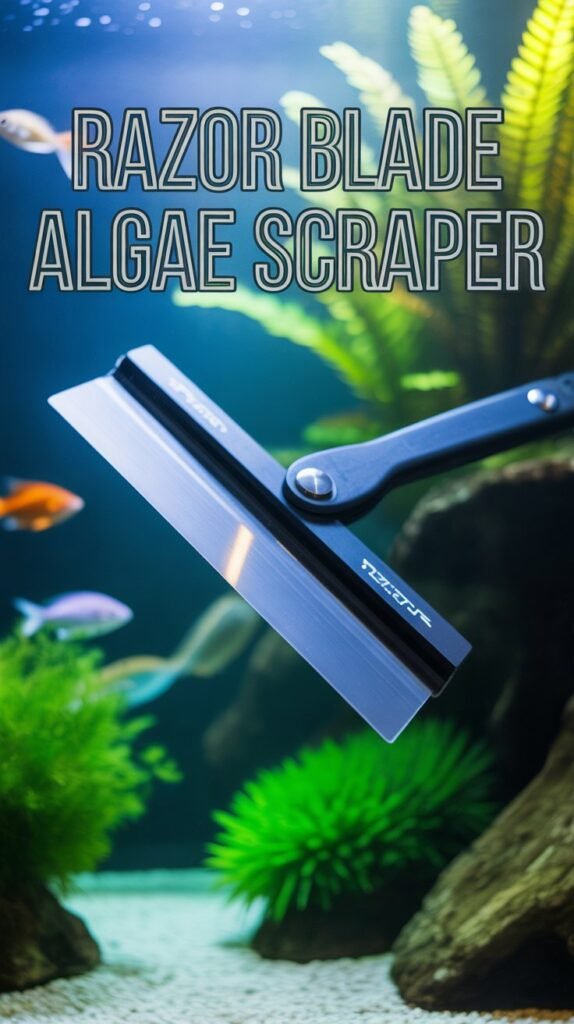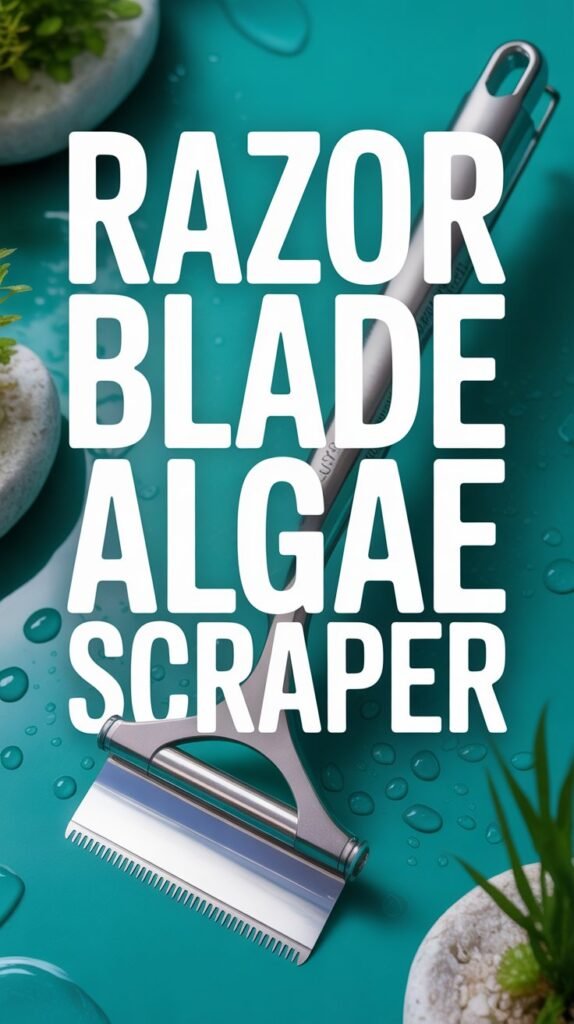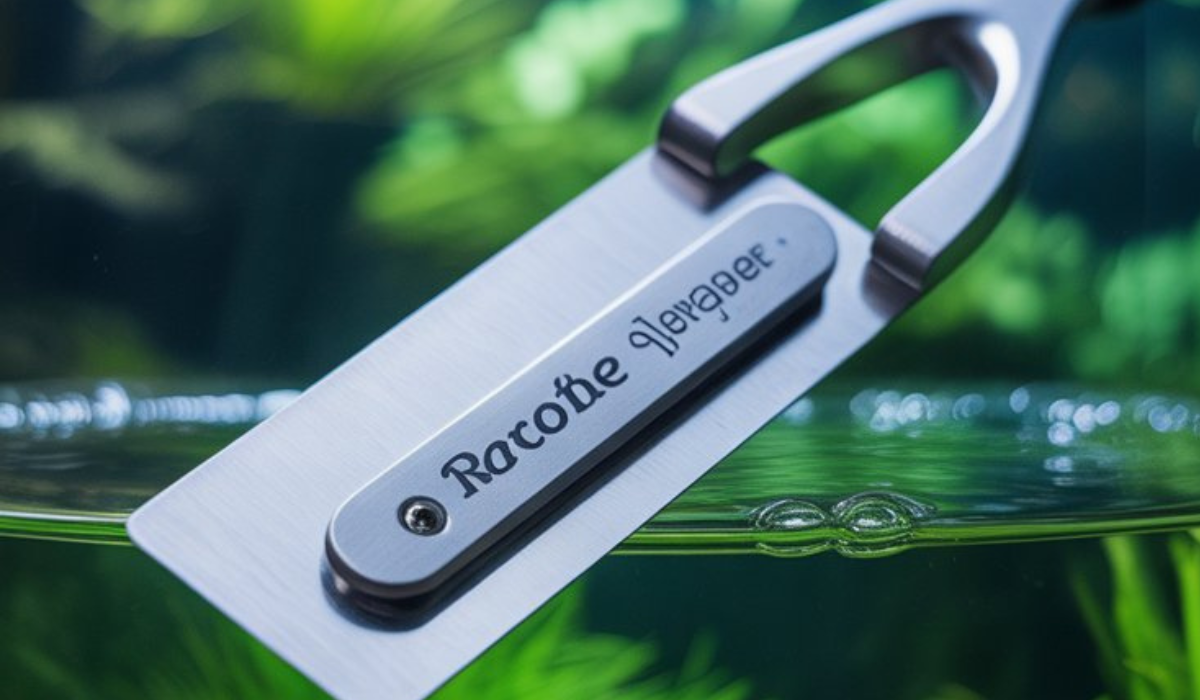Every aquarist dreams of a sparkling, crystal-clear aquarium where fish glide gracefully and aquatic plants flourish. However, one common challenge that aquarium enthusiasts face is algae growth. Over time, algae can build up on the glass, decorations, and equipment, turning a once-pristine tank into a greenish mess.
That’s where a Razor Blade Algae Scraper comes in. This simple yet powerful tool is one of the most effective ways to remove stubborn algae buildup from aquarium glass. Unlike sponges or magnetic cleaners, a razor blade scraper cuts through even the most stubborn layers of green spot algae, diatoms, and other film-like growth without leaving scratches when used properly.
In this guide, you’ll learn everything about razor blade algae scrapers—how they work, their types, safety tips, proper usage, maintenance, and how they compare to other algae removal tools. Whether you have a freshwater or saltwater setup, this comprehensive article will help you achieve a cleaner, healthier aquarium environment.
What Is a Razor Blade Algae Scraper?
A Razor Blade Algae Scraper is a handheld or extendable tool equipped with a stainless steel or plastic blade designed to remove algae from aquarium glass or acrylic surfaces. The sharp edge of the blade gently scrapes algae off without damaging the tank wall when used correctly.
It’s essentially a specialized razor holder optimized for aquariums. The blade sits at a specific angle that allows you to glide it smoothly over the glass, removing algae buildup in seconds. Razor scrapers are especially effective on hard green spot algae, which often resists traditional scrubbing methods.
Why Use a Razor Blade Algae Scraper?

Algae scrapers offer several advantages compared to sponges, brushes, or magnets:
1. Superior Cleaning Power
Razor blades can remove tough, encrusted algae that softer tools leave behind, including green spot and coralline algae.
2. Scratch-Free Results
When used properly, stainless steel blades won’t scratch glass. Plastic blades are safe for acrylic tanks.
3. Efficiency
You can clean a large tank quickly, even if algae has built up for weeks.
4. Cost-Effective
Razor blade scrapers are inexpensive and only require occasional blade replacement.
5. Precision Cleaning
They allow you to clean corners, edges, and hard-to-reach areas that magnetic scrapers can’t access.
Types of Razor Blade Algae Scrapers
Not all algae scrapers are the same. Depending on your aquarium setup and personal preferences, you can choose from different designs and materials.
1. Handheld Razor Blade Scraper
This is the most common type. It features a handle with a single blade at the end. Perfect for small to medium aquariums where you can easily reach all surfaces.
Pros:
- Easy to control
- Compact and affordable
- Perfect for spot cleaning
Cons:
- Not ideal for deep tanks
2. Extendable Razor Blade Scraper
This type features a long handle or telescopic extension, making it ideal for large or tall tanks. You can clean deep areas without getting your hands wet.
Pros:
- Great for big aquariums
- Keeps hands dry
- Reduces strain during cleaning
Cons:
- Slightly higher cost
- Harder to maneuver in tight corners
3. Magnetic Razor Blade Scraper
Combines the benefits of magnetic cleaners with a blade attachment. You can clean the glass from the outside by moving the magnetic handle, and the blade scrapes the inside surface.
Pros:
- Hands-free cleaning
- Ideal for daily maintenance
Cons:
- Less precise than handheld tools
- Risk of trapping sand or debris that could scratch glass
4. Plastic Blade Scraper
For acrylic tanks, stainless steel blades can cause scratches. Plastic blade scrapers are designed specifically for acrylic surfaces, offering safety without compromising performance.
Pros:
- Safe for acrylic
- Lightweight and rust-proof
Cons:
- Less effective on hard algae compared to steel blades
5. Electric or Motorized Razor Scraper
A newer innovation in aquarium maintenance, electric scrapers use vibration or motion to clean surfaces automatically.
Pros:
- Minimal effort required
- Consistent cleaning results
Cons:
- Expensive and requires batteries
- Limited availability
Choosing the Right Razor Blade Algae Scraper

When choosing the ideal scraper, consider the following factors:
1. Tank Material
- Use stainless steel blades for glass tanks.
- Use plastic blades for acrylic tanks.
2. Tank Size
For deeper or larger tanks, go for an extendable scraper to reach every corner.
3. Blade Angle
Look for scrapers with an adjustable blade angle. It makes cleaning smoother and reduces the risk of scratching.
4. Grip Comfort
Choose a scraper with an ergonomic handle to ensure comfortable use, especially for large tanks.
5. Blade Quality
Blades should be stainless steel (rust-resistant) or replaceable plastic. Always choose aquarium-safe materials.
How to Use a Razor Blade Algae Scraper Safely
Using a razor blade scraper is simple, but technique and care are important to prevent scratches or injuries.
Step-by-Step Guide:
- Turn Off Aquarium Equipment
Turn off filters and air pumps to stop debris from circulating. - Check Blade Condition
Ensure the blade is sharp, clean, and free of rust. A dull blade can scratch the glass. - Wet the Glass
Always scrape underwater. This reduces friction and prevents scratching. - Hold at an Angle
Hold the blade at a 30–45° angle to the glass. Too flat may not clean effectively, too steep can scratch. - Use Gentle Pressure
Apply steady, even pressure. Avoid pressing too hard, especially on curved glass. - Move Slowly
Use slow, deliberate strokes from top to bottom. Avoid sudden movements. - Clean Corners Carefully
Use short, light strokes or a corner scraper attachment. - Wipe Away Debris
After scraping, use an algae pad or net to remove floating particles. - Rinse the Blade
Rinse and dry the blade after every use to prevent rust.
Maintenance and Blade Care
Proper maintenance ensures your scraper lasts long and performs effectively.
1. Clean After Every Use
Rinse with fresh water and dry with a soft cloth. Avoid leaving it in the tank.
2. Replace Blades Regularly
Over time, blades lose sharpness. Replace them every few weeks or when you notice reduced efficiency.
3. Store Safely
Keep blades in a dry area, away from children or pets.
4. Avoid Saltwater Corrosion
For marine aquariums, rinse the scraper with freshwater after use to prevent salt corrosion.
Benefits of Using a Razor Blade Algae Scraper

1. Keeps the Tank Visually Appealing
Crystal-clear glass enhances your aquarium’s aesthetics, allowing you to enjoy the full beauty of your fish and aquascape.
2. Promotes Fish Health
Excess algae can block light and reduce oxygen exchange. Regular cleaning improves water quality and fish well-being.
3. Easy Maintenance
Unlike magnetic or sponge cleaners, a razor scraper provides immediate, visible results with minimal effort.
4. Saves Money
No need for expensive cleaning solutions or equipment. Blades are inexpensive and easy to replace.
5. Ideal for Stubborn Algae
Green spot algae, diatoms, and coralline algae are no match for a sharp razor blade.
Razor Blade vs. Magnetic Algae Scraper
| Feature | Razor Blade Scraper | Magnetic Algae Scraper |
|---|---|---|
| Cleaning Power | Superior for tough algae | Moderate |
| Control | Precise | Limited |
| Risk of Scratches | Low (if careful) | Medium (if sand gets trapped) |
| Ease of Use | Requires manual effort | Convenient |
| Ideal Use | Deep or stubborn algae | Daily light cleaning |
Verdict:
Use razor scrapers for deep cleaning and magnetic scrapers for daily maintenance.
Tips for Preventing Algae Build-Up
A razor scraper is great for cleaning, but preventing algae is even better.
- Control Lighting: Avoid excessive light exposure. Keep lights on for 8–10 hours daily.
- Manage Nutrients: Overfeeding increases phosphate and nitrate levels, fueling algae growth.
- Regular Water Changes: Perform 25–30% water changes weekly.
- Use Live Plants: Live plants outcompete algae for nutrients.
- Add Algae Eaters: Snails, shrimp, and plecos can help control growth naturally.
- Monitor Water Quality: Maintain good filtration and test for nitrate and phosphate levels.
Using Razor Blade Scrapers in Different Aquarium Types
1. Freshwater Aquariums
Ideal for removing green spot algae, diatoms, and soft film algae. Use a stainless-steel scraper for glass tanks and plastic for acrylic.
2. Saltwater Aquariums
Effective against coralline algae, which can form hard crusts on glass. Rinse the scraper thoroughly after use to avoid corrosion.
3. Planted Tanks
Use gently around plants to prevent uprooting delicate stems. Scrape carefully near decorations and driftwood.
4. Acrylic Aquariums
Only use plastic blades to avoid permanent scratches. Apply minimal pressure.
Common Mistakes to Avoid
- Using Rusty or Dull Blades
Dull edges can scratch the glass. Always inspect before use. - Scraping Dry Glass
Never scrape outside of water. Dry surfaces increase friction and risk scratches. - Using Steel Blades on Acrylic
This can cause irreparable damage. Always match blade material to tank type. - Rushing the Process
Cleaning too fast may cause slips or injuries. - Forgetting to Rinse After Use
Residual salt or moisture can lead to corrosion.
DIY Razor Blade Algae Scraper
If you’re on a budget, you can make a simple scraper at home.
Materials:
- Standard razor blade or paint scraper blade
- Handle (old toothbrush, chopstick, or plastic rod)
- Waterproof adhesive
Instructions:
- Attach the blade securely to the handle using adhesive or duct tape.
- Let it dry completely.
- Test gently on a small glass area before full use.
Note: Always ensure the blade is rust-resistant and clean before inserting into the tank.
Safety Tips When Using a Razor Blade Scraper
- Handle with care; blades are extremely sharp.
- Keep away from children.
- Never use blades with visible rust or chips.
- Store with a blade cover or sheath.
- Use gloves if handling near sharp edges or rocks.
- Discard used blades safely (wrap in paper before disposal).
Environmental Impact of Algae Control
Using a razor blade scraper is an eco-friendly cleaning method. Unlike chemical algae removers, it does not release harmful substances into the aquarium. It’s purely mechanical cleaning, safe for fish, plants, and beneficial bacteria.
Advantages of Regular Glass Cleaning
- Enhanced Viewing Experience: Enjoy a clearer view of your fish.
- Better Light Penetration: Light reaches plants efficiently, promoting photosynthesis.
- Reduced Maintenance Time: Frequent light cleaning prevents heavy buildup.
- Improved Tank Aesthetics: A clean aquarium looks more professional and inviting.
Troubleshooting Algae Growth
If algae keeps returning even after scraping, investigate these causes:
| Cause | Solution |
|---|---|
| Excess nutrients | Reduce feeding, improve filtration |
| Too much light | Lower light intensity or duration |
| Poor water changes | Increase frequency |
| Weak plant competition | Add more fast-growing plants |
| Imbalance in CO₂ | Stabilize injection system (for planted tanks) |
By balancing your aquarium’s ecosystem, algae growth will reduce naturally.
Conclusion
A Razor Blade Algae Scraper is one of the most effective, low-cost, and reliable tools for keeping aquariums spotless. Whether you’re battling stubborn green spot algae on glass or coralline algae in a saltwater tank, this scraper delivers professional-level cleaning results with minimal effort.
Regular use ensures your tank remains clear, your fish stay healthy, and your underwater world remains visually stunning. With the right blade, proper care, and safe techniques, algae cleaning will transform from a dreaded chore into a simple, satisfying routine.
Frequently Asked Questions (FAQs)
1. What is the best razor blade scraper for aquariums?
The best one depends on your tank type. Stainless steel scrapers are ideal for glass tanks, while plastic blade scrapers are perfect for acrylic tanks.
2. Can a razor blade scraper scratch my aquarium glass?
Not if used properly. Always scrape underwater and hold the blade at a 30–45° angle with gentle pressure.
3. How often should I clean my aquarium glass?
Light cleaning every week prevents algae buildup. Deep cleaning with a razor scraper can be done monthly or as needed.
4. Are razor blade scrapers safe for planted tanks?
Yes, just use them carefully near plants to avoid disturbing the substrate.
5. Can I use a regular razor blade instead of an aquarium scraper?
You can, but ensure it’s stainless steel and rust-resistant. Dedicated aquarium scrapers are safer and more convenient.
6. How do I clean a rusty blade?
Never use a rusty blade in an aquarium. Replace it immediately with a new one.
7. Are magnetic scrapers better than razor blade scrapers?
Magnetic scrapers are convenient for daily use, but razor scrapers are superior for deep cleaning tough algae.
8. Can I use a razor scraper in saltwater tanks?
Yes, but rinse the blade with freshwater after each use to prevent corrosion.
9. How do I prevent algae from coming back after scraping?
Control lighting, reduce nutrients, and maintain regular water changes.
10. How long does a blade last?
Depending on use, a stainless steel blade typically lasts 2–4 weeks before needing replacement.

